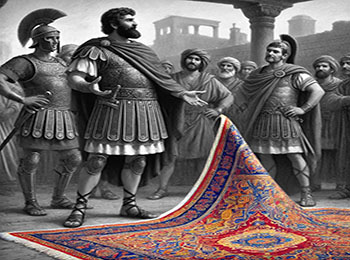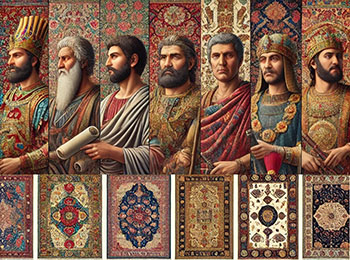The origins and first mentions of the handmade Persian rug
The origins of Persian rugs date back thousands of years, when nomadic tribes in Iran began making these handmade rugs to protect themselves from the cold and to decorate their homes. The first Persian carpets probably appeared in simpler forms, but the fine patterns and intricate knotting techniques developed early on. The first historical references come from ancient Greek sources, such as the writings of Xenophon, who noted around 401 BC that Persian carpets were already a symbol of luxury and wealth. One of the most famous and earliest surviving examples is the Pazyryk rug, dating from the 5th century BC, found in a tomb in the Altai Mountains. This carpet demonstrates not only the high level of knotting technique, but also the importance of Persian carpets in trade and cultural relations. The making of Persian carpets has evolved steadily since then, but the first references to them show that they were highly valued even in ancient times.

The beginnings of Persian carpet weaving: 500 BC - 200 AD
The history of Persian carpet weaving began around 500 BC, when the Achaemenid Empire was flourishing. By this time, carpets were not only part of everyday life, but had become a symbol of luxury in royal courts and palaces. Achaemenid kings such as Cyrus the Great and Darius were famous for their wealth, and the carpeted halls of their palaces reflected the grandeur of the empire. The next important period for carpet making was the Seleucid Empire (330 BC - 150 BC) and the Parthian Empire (247 BC - 224 AD). During this period, the art of carpet making continued to develop, new weaving techniques were introduced and carpets became more refined and detailed. By the Parthian period, Persian carpets had reached the Roman Empire, where Persian craftsmanship became a highly sought after luxury item.

History of handmade Iranian carpets over the centuries
The history of Iranian carpets has evolved and improved over the centuries. Hand knotted carpets have always been an integral part of Persian culture and identity, and the knotting techniques have been passed down from generation to generation. During the Sassanid Empire (224 - 651 AD), carpet weaving became a true art, and the finest pieces were used in the royal courts, palaces and mosques of the empire. During the period of Islamic conquest and the Caliphate (from the 7th century onwards), Persian carpets gained new inspiration from Arab artistic influences. Islamic decorative motifs, geometric shapes and calligraphy appeared in the patterns of the carpets and further enriched the visual world of handmade Persian carpets. During the Safavid dynasty (1501-1736), Persian carpet weaving reached new heights. During this period, a system of carpet production was established that extended to all corners of the empire. The city of Isfahan became the centre of carpet making, and Persian carpets of this period were renowned throughout the world for their detailed designs, sophisticated techniques and high quality.
The role of Persian carpets in ancient and medieval Iran
In ancient and medieval Iran, Persian carpets were not only everyday objects but also played an important role in social and economic life. They reflected the wealth and power of noble families and royal courts, and were often given as diplomatic gifts to rulers of other countries. The quality and elaborateness of the carpets also indicated the rank of the owner. Persian rugs have become one of the most valuable exports of Iranian trade, and different styles have developed in different regions of the country, characterised by unique designs and weaving techniques.

